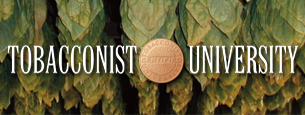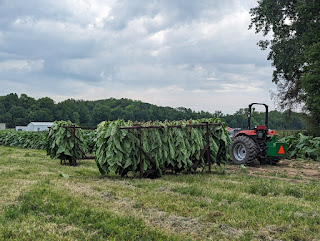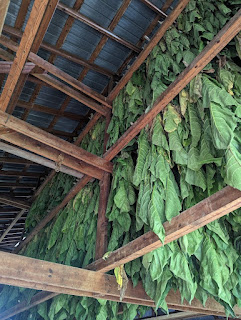“What do you think?” Corey asked me when I stepped foot onto the open empty field. It was a warm Saturday morning in May, and I had no idea what my expectations were or how taking this risk would become one of the greatest learning experiences I ever had. I simply smiled, “We will see.” Like many things in life, patience and hard work can cultivate a lot of results. Growing tobacco can bring this to the surface. I was taught on how to grow tobacco in the Northwest corner of Missouri, in a small town called Dearborn. I learned techniques from the Dominican way and good old American ingenuity. Also, by a mix of machines and hands-on throughout the process.
To say I was optimistic was a bit of an understatement. As I
observed the open field there were no mountains, this wasn’t a valley by any
means… So, no nutrient erosion. Was it hot? Yes. But what about the soil? Was
it good enough to sustain and grow good hearty tobacco? This spot of land had a
slight slope and little to no tree coverage around the perimeter. The slope
helped on rainy days distribute the water absorbed into the soil richly among
the plants. The soil in this area is
heavy clay loam to sandy with high organic matter which helps the area grow a
variety of healthy crops. Corey described the land has been decent to tend but
is also learning about what varietal of tobacco grows the best. This year was
Broadleaf. The land was owned by the city of Dearborn and was next to the water
waste lake and a large creek. Just to the East there was a small corn field and
some city buildings… let’s just say I was given GPS coordinates to get to the
location.
Corey is Corey Frisbee, who started Weston Tobacco in 2010 with his son Colton. More like brothers than father and son; they worked together with very little to build a small, humble, homegrown business, that became a staple in the area. After Colton’s tragic passing, Corey couldn’t step foot back into Weston again but the passion he developed for tobacco continued to burn in him. He knew he needed to continue working with tobacco in some capacity and thus I encountered him on his third year of growing Missouri tobacco.
Every weekend from May to August I traveled to Dearborn and met with Corey to pick his brain about cigars and tobacco, as well as to learn all the hands-on farming. The field we would be planting on had grown everything from corn to hemp. During the off seasons Corey said they picked something that wouldn’t change the soil or need too much caring for. We prepped the soil by cultivating it by machine and by hand. The land was cultivated every week for several weeks before planting to ensure impurities such as old crop, sticks, rocks, and weeds were all removed. The field was also walked by foot to double check for these impurities prior to growing. There weren’t any chemicals added to the soil prior to planting. We ensured there were stacked mounds for the plants to be implanted on. We used a hand fed mechanical planter to drop the plants. Some of us would walk behind and ensure the plants were standing tall and hand planting the missed spots.
Throughout the coming weeks I would hoe the field by hand, pull weeds, cut the grass, cut off suckers, top the plants, even add a chemical that sealed the top where it was topped to help the tobacco continue to grow. Over the last couple of weeks in August we stalk cut the plants. Corey said in his experience stalk cutting Broadleaf was best. So, we cut and spike the plants on lathes before barn hanging them. It should be noted that as I write this, the plants are still hanging in the air-curing barn until about Thanksgiving when they will be packaged and sent to Hail and Cotton in Tennessee as well as several other vendors who purchased it.To give a broader perspective, after planting, the following weeks we began to really work and mind the fields. This was done by hoeing the mounds around the plants, making sure they had enough soil around to develop a sturdy, healthy base of the stalk. We continued to check for land impurities by walking the 3 acres by foot and checking every planted row. As the plants began to grow, they would sprout suckers or second shoots. In the next week we patrolled by foot again and took these off. It was important to do this for a strong base and to ensure the tobacco leaves have the best chance at proper growth and nutrient enrichments you need only one base or stalk.
In the last week of July and first weeks of August we began
to stalk cut and hang. Now around 9 weeks after we first planted, after all the
tending and pruning, it was time to cut. Stalk cutting caused a longer curingprocess, however it allows the tobacco to have a deeper, richer flavor. Stalk
cutting is the process of cutting the full tobacco plant several inches from
where the stalk meets the ground and spearing it on a lathe. The lathe is a
large wooden stick, at the end of this stick would be a metal, cylinder-shaped,
removable spike. This is actually a very dangerous process, says the new scars
on my hand and forearm… If you are not standing on the proper section of the
spike, you can easily get impaled when pushing the stalk onto the lathe.
Over the last several months of working on the field I
became very humbled by the process. To work with the soil and plants by hand,
to see everything I read and watched put into practice was rewarding. I can say
it was a unique experience. While working on the field I also continued my
education. Studying Cigars 101 and earning my Certified Cigar Sommelier Tobacconist (CCST) and Certified Retail Tobacconist (CRT) degrees from Tobacconist University. I also produced and taught a
Cigar 101 class for the cigar lounge I work at.
I spent the last 12 years as a law enforcement officer in
Kansas before taking a medical retirement last December. During my time there I
saw and experienced things that are hard to describe. To say I suffered mentally
is an understatement. I needed something to help me heal, something to give me
purpose. Cigars did that, growing tobacco did that, learning to roll did that.
Rolling has very quickly become a deep passion. Devin Ashley of Bad Ash
Cigars was my first teacher, followed by Corey. I still have my first rolled
cigar!
This regal life within the cigar world can give you a purpose if you are looking for one. It can also give you peace. I’ve met some fascinating, passionate, adoring people within this culture. No matter the path we find ourselves on we can always find an outlet in the cigar way of life.
















No comments :
Post a Comment